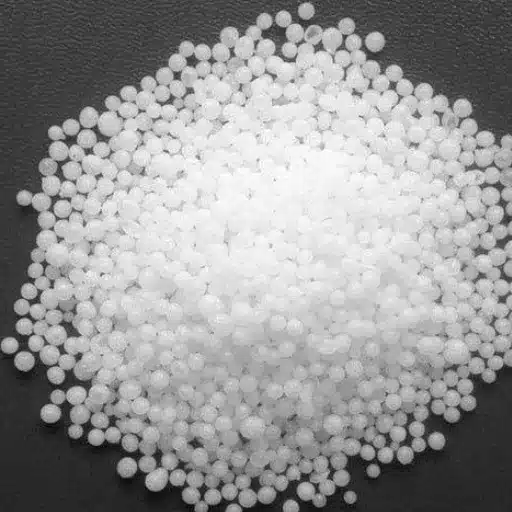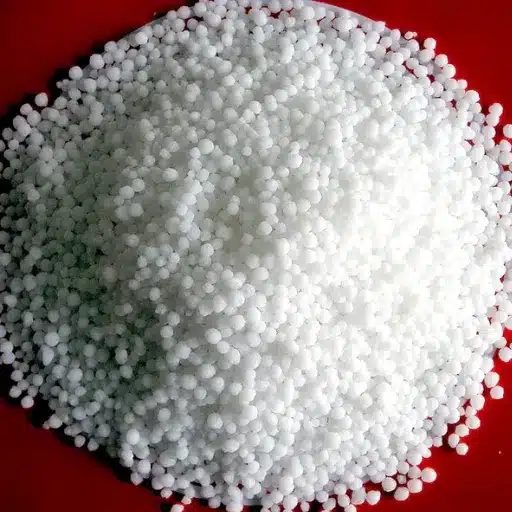Calcium nitrate fertilizer is perhaps the most important one to work with to obtain strong plant growth and higher yield. This powerful compound combines calcium and nitrate-two essential nutrients that can strengthen plant tissue, improve the soil, and help plants absorb nitrogen better. Due to the rising popularity of calcium nitrate among farmers and gardeners, it has become a good, sustainable option to rectify nutrient deficiencies and optimize crop health. In the article, we will look into how calcium nitrate fertilizer works, its advantages, and why it is considered a winning organic choice for accelerating plant growth.
Understanding Calcium Nitrate Fertilizer

What is Calcium Nitrate?
Calcium nitrate is an inorganic compound that acts as a highly effective fertilizer and is extensively used in agriculture. The chemical makeup consists of calcium together with nitrogen in the guise of two nitrate ions and oxygen molecules, represented by Ca(NO₃)₂. Calcium and nitrogen form two very important nutrients required by plants for growth and development.
Calcium strengthens plant cell walls, conferring generally better structural properties and resistance to diseases. Nitrate nitrogen, on the other hand, is a quick-acting nitrogen source that nourishes photosynthesizing plants and stimulates vegetative growth. Since it serves as a nutrient with dual action, calcium nitrate is, therefore, among the fertilizers most widely recommended for various crops such as vegetables, fruits, and ornamentals.
In the Ca(NO₃)₂ fertilizer, water solubility is one big plus-that is, calcium nitrate dissolves readily for rapid absorption through plant roots. Additionally, calcium nitrate corrects calcium deficiencies in the soil while simultaneously halving soil salinity and encouraging a balanced pH level. For these reasons, calcium nitrate is a darling of modern agriculture, especially in areas where soils are depleted or poor in nutrients.
Benefits of Calcium Nitrate for Plant Health
- Strong Cell Wall Promotion: The plant cell wall formation requires calcium ions supplied by calcium nitrate. Strengthening of the cell walls in stems and leaves enables such plants to better resist more to physical injuries and harsh environmental conditions.
- Root Development: Plant roots absorb readily the nitrate form of nitrogen from calcium nitrate, which guarantees an instant supply of this vital nutrient. Nitrogen is required for the elongation and branching of roots so that water and nutrient uptake from the soil takes place efficiently.
- Improvement in Fruit Quality and Shelf Life: Calcium is very important in maintaining fruit firmness and quality. Calcium nitrate reduces physiological disorders, such as blossom-end rot on tomatoes and bitter pit on apples, hence ensuring good quality and longer shelf life for fruits. Studies have found that fruits sprinkled with calcium have a shelf life increased by about 25-30 per cent compared to those deprived of calcium.
- Reduces Soil Salinity and pH Imbalances: Calcium nitrate reduces soil salinity by the substitution of sodium ions with calcium ions, thereby improving soil structure and aeration. Calcium nitrate also steadies soil pH level by an even supply of required nutrients to create environmental conditions for good plant growth.
- Increases the Efficiency of Photosynthesis: With nitrogen in nitrate form, it stimulates the synthesis of chlorophyll, which, in turn, increases the rate of photosynthesis in plants. Consequently, more energy formation results, giving plants greater growth vigor and more immense potential for grip. The data records to 15% yield increase in calcium nitrate-treated crops, under ideal circumstances.
How Calcium Nitrate Affects Soil Quality
Calcium nitrate maintains an exceedingly unique and positive influence on soil quality, with the supply of nutrients necessary to enhance soil health and fertility. Mainly, it supplies calcium and nitrogen readily available for use by the plants; both elements are quite important for plant growth. Calcium helps bind soil particles, enhancing the soil structure to allow for aeration and water infiltration while preventing problems such as soil compaction and waterlogging that obstruct root expansion and nutrient uptake.
Thus, calcium nitrate counteracts soil acidity when applied properly. Acidic soils restrict some essential nutrients, which, in turn, affects plant health. Neutralizing excessive acid levels keeps the soil at the right pH to allow nutrient absorption, such as phosphorus and potassium, thereby increasing soil productivity for balanced meal delivery to plants.
Also, calcium nitrate prevents the development of soil salinity, which reduces water absorption by plants and stunts growth. Different from fertilizers that contribute to salt build-up in soils, calcium nitrate dissolves fast with no harmful residues left behind. These characteristics make it desirable for maintaining an equilibrium in the soil, especially in places prone to salinity or nutrient depletion; its use ensures the long-term sustainability of the soil for the healthy practice of agriculture and better crop yields.
Calcium Nitrate in Organic Farming Systems

Role of Calcium Nitrate in Certified Organic Practices
Among all fertilizers, calcium nitrate in particular finds far greater application in conventional agriculture; however, under strict regulatory conditions, it can sometimes find a place in certified organic practices. Certified organic agricultural setups permit calcium nitrate with some restrictions. The following are five key functions and specifications concerning the use of calcium nitrate in certified organic systems:
- Improved Soil Structure and Fertility: Calcium nitrate imparts calcium ions into the soil that act to preserve soil structure. Aggregation of soil particles by calcium gives good aeration and water infiltration in soils. This role is essential in organic systems, where the main focus is on soil conservation.
- Efficient Nitrogen Delivery: Calcium Nitrate supplies nitrogen in an immediately plant-available form, i.e., nitrate (NO₃⁻). Though organic farming prefers nitrogen sources that release slowly, in particular cases, calcium nitrate is sometimes allowed as an exception to treat acute nutrient deficiencies.
- Calcium Deficiency Management of High-Value Crops: Among high-value crops, calcium deficiency induces physiological disorders in tomatoes, peppers, and lettuce, routinely produced under organic farming. Target calcium nitrate applications would ameliorate calcium-poor soils or foliar-induced calcium deficiencies within the limits presaging organic certification.
- Enhanced Nutrient Uptake Synergies: Synergizing calcium nitrate enhances the absorption of other essential nutrients by plants, such as potassium and magnesium. Such a multi-nutrient synergy is of utmost importance for balancing organic cropping systems that minimize external inputs.
- Locally Applied with Lowest Environmental Impact: Calcium nitrate by drip decisions allows nutrients to localize while minimizing nutrient leaching, and contaminations are kept low. Application targeted at minimizing adverse environmental impacts, which was the best practice in organic mode.
These points denote the controlled and regulated application of calcium nitrate in certified organic systems that portray its benefits on occasion of certain given conditions while maintaining the principle of sustainability.
Comparative Analysis of Fertilizers

Calcium Nitrate vs. Conventional Fertilizers
In nature, calcium nitrate is both a calcium and nitrate nitrogen source for growth, whereas conventional fertilizer systems focus on three important macronutrients: nitrogen, phosphorus, and potassium, often missing calcium.
| Aspect | Calcium Nitrate | Conventional Fertilizers |
|---|---|---|
| Components | Calcium, Nitrate | N, P, K, Micronutrients |
| Dissolvability | High | Varies |
| Uptake Speed | Quick | Slower |
| Usage Methods | Soil, Foliar, Hydroponic | Soil, Foliar |
| Deficiency Aid | Calcium, Nitrogen | General Nutrients |
| Eco Impact | Low Leaching | Potential Leaching |
| Expense | Moderate | Varies |
| Organic Suit | No | Sometimes |
| Crop Fit | Tomatoes, Peppers | General Crops |
| Longevity | Enhances | Neutral |
Integrating Calcium Nitrate into Organic Gardening
Calcium nitrate can be a synthetically procured fertilizer that can also be used under special circumstances as a secondary fertilizer for organic gardening systems. In the realm of plant nutrition, calcium nitrate acts as an almost immediately accessible calcium and nitrate nitrogen source. Calcium contributes to the reinforcement of cell walls and ensures good qualities in fruits, while nitrate supports vegetative growth and chlorophyll development.
Yet, for calcium nitrate to be used in any organic garden, much attention must be given to ensure that it is in line with environmentally sustainable principles. One such example could be the application of calcium nitrate in a soil system or a controlled hydroponic set-up, as it helps minimize the risk of leaching into groundwater-having been seen as one of the major ecological concerns. On the other hand, calcium nitrate might be best applied with a slow-release organic fertilizer so that immediate plant needs can be balanced with the long-term development of soil health.
Organic farming certification generally will not allow calcium nitrate use. Therefore, toward maintenance of organic integrity, gardeners should only use it in rare, targeted applications under a broader integrated plant nutrient management approach. Developments in agricultural technologies, especially in biodegradable nitrate delivery systems, could soon merge the synthetic with the organic.
Calcium Nitrate vs. Other Organic Fertilizers
In brief, calcium nitrate is a fast-acting fertilizer providing calcium and nitrate nitrogen, while organic fertilizers are slow-acting sources with broader benefits for soil health.
| Aspect | Calcium Nitrate | Organic Fertilizers |
|---|---|---|
| Nutrients | Calcium, Nitrate | N, P, K, Micronutrients |
| Release Speed | Fast | Slow |
| Soil Impact | Neutral | Improves Structure |
| Eco Impact | Synthetic | Natural |
| Application | Soil, Foliar, Hydroponic | Soil, Compost |
| Cost | Moderate | Higher |
| Organic Use | No | Yes |
| Suitability | Deficiency Fix | Long-Term Health |
| Leaching Risk | Low | Minimal |
| Microbes | Neutral | Supports |
Calcium Nitrate vs. Synthetic Fertilizers
Calcium nitrate supplies calcium and nitrate nitrogen for quick absorption, while synthetic fertilizers supply macronutrients such as nitrogen, phosphorus, and potassium with variable rates of release.
| Aspect | Calcium Nitrate | Synthetic Fertilizers |
|---|---|---|
| Nutrients | Calcium, Nitrate | N, P, K, Micronutrients |
| Release Speed | Fast | Varies |
| Soil Impact | Neutral | Varies |
| Eco Impact | Low Leaching | Potential Leaching |
| Application | Soil, Foliar, Hydroponic | Soil, Foliar |
| Cost | Moderate | Varies |
| Deficiency Fix | Calcium, Nitrogen | General Nutrients |
| Crop Fit | Tomatoes, Peppers | General Crops |
| Longevity | Enhances | Neutral |
| Organic Use | No | No |
Advantages and Disadvantages of Calcium Nitrate
✅ Advantages of Calcium Nitrate
- Enhances Calcium and Nitrogen Availability: Calcium nitrate provides readily available calcium and nitrate nitrogen, both elemental nutrients essential for plant growth. This entails the formation of the strongest cell wall and thus maximum plant growth.
- Fast Nutrient Release: Calcium nitrate releases its nutrients at a relatively fast rate; therefore, it is used when addressing acute calcium or nitrogen deficiency symptoms in plants. For instance, deficiency symptoms appearing in tomatoes and peppers are instantly removed using calcium nitrate due to its fast reaction.
- Low Environmental Impact: It has a very low leaching potential compared with some other fertilizers and alternative land use, thus dispersing nutrients on the run-off and hence contamination of water bodies.
- Versatile Application: It can be used for soil application, foliar feeding systems, or hydroponic systems, and can be adapted to diverse agricultural practices.
- Prolong Crop Life Span: The nutrient composition improves crop life span and quality, especially for crops like fruits and vegetables, where calcium has a major bearing on post-harvest shelf life.
❌ Disadvantages of Calcium Nitrate
- Non-Organic Composition: Calcium nitrate is not registered as an organic fertilizer and thus cannot be used in any organic farming systems, restricting its application among organic growers.
- Moderate Cost: Calcium nitrate is one of the costlier fertilizers and may therefore not be feasible for farmers working with limited budgets or on a large scale.
- Salt Build-Up Risk: If applied repeatedly for long periods, salts may build up in the soil, affecting soil structure and fertility potential.
- Limited Nutrient Spectrum: Calcium nitrate primarily supplies calcium and nitrate nitrogen and does not provide other macro- or micronutrients that may be required.
- Specific Crop Suitability: This fertilizer is specially suitable for crops that demand calcium, such as tomatoes and peppers; its performance may be less meaningful for some crops with different nutrient needs.
Application Methods for Calcium Nitrate Fertilizer
Proper Dosage for Different Crops
Calcium nitrate regulation rates change drastically considering the crop type, soil condition, and growth stage. Given below are some general usage recommendations:
- 🍅 Tomatoes: 1-2 lb of calcium nitrate to be applied every 2-4 weeks, during the vegetative stage, per 1000 square feet. In bigger operations, it translates into somewhere in the vicinity of 150-200 lb per acre, depending on the outcome of soil tests.
- 🌶️ Peppers: Apply 1.5-2 lb per 1000 square feet during the early growth stage, increasing this during the fruiting period to 2-3 lb to satisfy the calcium demand and decrease blossom-end rot incidence.
- 🥬 Lettuce: Apply 0.75-1 lb per 1000 square feet every few weeks, preferably as a side dressing. Controlled applications prevent excessive accumulation of nitrates.
- 🌳 Fruit Trees: Spread 0.5-1 lb of calcium nitrate per inch of trunk diameter around the drip line for mature trees yearly, adjusting this according to soil nutrient tests and the manifestation of deficiencies.
Ensure calcium nitrate is mixed with soil well to prevent surface accumulation and volatilization for best results. It is recommended to look up regional agronomic data and perform regular soil analyses to adjust application rates according to local environmental conditions and crop requirements.
Timing of Application for Maximum Effectiveness
It is fairly critical in finishing nutrient application to maximize nutrient uptake and enhance crop response. Hence, for most crops, calcium nitrate application is best during the active stages of growth, especially around early vegetative phases and before flowering or fruit set when nitrogen and calcium demands peak. Avoid such calcium nitrate applications during dormant periods or during times of excessive water stress since nutrient uptake efficiency under such conditions is quite low.
Calcium nitrate application following irrigation adequately moistens the soil to enable root absorption. This application reduces nutrient leaching and greatly ensures direct nutrient availability in the root zone. Split applications, or the division of the total recommended amount into several smaller doses across the growth season, further ensure steady nutrient release and availability, lessening the chance of stress or toxicity to the plants.
Recent field trials and regional guidelines underscore the importance of application schedules tailored for individual crops and environmental conditions. For instance, calcium nitrate application may be done for leafy vegetables at every two-week intervals, while the timing must be stricter for fruit-bearing crops such as tomatoes, aligned with the flowering stages and fruit development. Relying on scientific agronomic data and dismissing generic schedules, thereby ensuring that nutrient management is site-specific and data-driven for optimum agricultural results.
Techniques for Applying Calcium Nitrate in Various Soil Types
There is a need to know the characteristics of a specific soil to understand the best possible way of calcium nitrate application to optimize nutrient uptake and minimize loss. Calcium nitrate should be supplied in relatively small doses at more frequent intervals in sandy soils due to the leaching possibilities. This creates less loss of nutrients by water infiltration, besides ensuring the continuous presence of calcium and nitrogen for the root zone to absorb. In contrast, for clay soils with low permeability, a light irrigation is necessary after application to avert nutrient lockup at the surface and support the downward movement into the root layer.
Loam soils, with balanced texture and fertility, go well with more traditional methods of application, such as broadcasting or fertigation, depending on the crop. Incorporation methods, though, such as light tillage, can further enhance nutrient availability by mixing calcium nitrate uniformly inside the active root zone. Acidic soils are likely to need lime amendments in conjunction with calcium nitrate to prevent interference with nutrient availability due to low pH conditions.
Increasingly, precision techniques, such as fertigation systems, are being promoted for application regardless of soil type, whereby controlled irrigation waters down the nutrients towards roots with a near-zero waste. Consideration of site-specific factors like pH, cation exchange capacity (CEC), and moisture level is required to efficiently tailor application methodology to specific soil profiles and further maximize agricultural yield.
Practical Tips for Using Calcium Nitrate in Your Garden

Selecting Quality Calcium Nitrate Fertilizer
The chemical purity and nutrient composition of calcium nitrate fertilizer are essential in attaining the desired results. Calcium nitrate of good quality should contain a minimum of 15.5% nitrogen and 19% calcium; these two are crucial factors in promoting vigorous plant growth and cell wall development. Those products having a low level of contaminants, particularly heavy metals or insoluble compounds, are preferable since they tend to cause toxicity and blockages in the irrigation systems. Furthermore, selecting formulations appropriate for the application procedure under consideration (granular forms or water-soluble types) assures compatibility with your fertilization practice.
Another factor worthy of consideration is the solubility and consistency of the fertilizer. Water-soluble calcium nitrate dissolves fully and leaves no residues, thereby being ideal for fertigation systems and hydroponics. To verify this, the product specifications should be checked as reputable manufacturers usually provide data sheets including solubility rate, pH value when dissolved, and suggested application rate. Ensuring the correct level of solubility maximizes nutrient availability and lessens the chances of clogging through drip irrigation systems.
Finally, for calcium nitrate fertilizer selection purposes, it might prove fruitful to examine packaging and storage recommendations. These would ensure the fertilizer’s quality for a reasonable duration. Typically, good fertilizers are packed in moisture-proof packaging that can avert caking and degradation through ambient humidity. Products sourced from recognized brands or distributors with well-implemented quality control measures are preferred to avoid adulterated formulations. In comparison, the abovementioned criteria, when combined with good agricultural practices, will surely enhance plant productivity while ensuring cost-efficiency in the long run.
Using Calcium Nitrate for Tomatoes and Other Crops
Calcium nitrate is a crucial source of calcium and nitrogen-two essential nutrients for enhanced growth and development of tomato, along with many other crops. It being a water-soluble fertilizer is a highly useful fertilizer for application to the soil or via a fertigation system. Calcium helps in strengthening the cell walls, which improves fruit quality and reduces physiological disorders like blossom end rot on tomatoes. Nitrogen, conversely, helps in vegetative growth and in supporting metabolic activities inside the plant. Thus, calcium nitrate acts simultaneously to give balanced nutrition to increase both yield and fruit quality.
In using calcium nitrate, I always ensure it is dissolved well to guarantee even distribution and ease of uptake by plant roots. For tomatoes, the flowering or fruiting stage is when I usually make applications since these periods are the greatest demand for calcium and nitrogen to keep the plants healthy and productive. Feeding in a wide range of doses normally depends on the needs of the crop and soil conditions; however, I usually follow the guidelines from a reputable organization or do a soil test to determine the best rate of application. It is equally important to check crop performance regularly to modify the application program, if necessary, to avoid over-application and possible nutrient imbalances.
Calcium nitrate can also be used in foliar feeding programs, especially when there is a need to treat localized calcium deficiency in fruit or leaves. I have found this method to be very effective for emergency cases where calcium uptake along the root route is compromised due to environmental stressors. To prevent leaf scorching and other damage, careful attention is given to dilution ratios and application times. Applications should be done either in the morning or late evening, during cooler periods. Thus, efficient utilization of calcium nitrate ensures the well-being of tomatoes and other crops, contributing to sustainability and profitable agriculture.
Managing Blossom End Rot with Calcium Nitrate
Blossom end rot (BER) is a physiological disorder primarily caused by calcium deficiency during critical stages of fruit development. The proper management of BER calcium nitrate—a highly soluble calcium and nitrogen source—is universally accepted and utilized in all fields of agriculture in remedying this physiological disorder. Experiments showed that if applied properly, calcium nitrate application to the soil or as a foliar feed would mostly serve to reduce the susceptibility to BER.
Research studies confirm that applications of calcium nitrate increase calcium mobility in plants and quickly overcome deficiencies induced or exacerbated by fluctuations in soil moisture levels. Farmers who tested calcium in soils and applied calcium nitrate where required reported up to a 30% reduction in BER in crops in ideal growing conditions. Above the recommended dose, however, the rate of application will be diminished if irrigators are not able to keep moisture evenly distributed in drying crops. This is of prime importance.
Knowing calcium uptake will aid in improving any of these proposed strategies. Since plants transport calcium to the environment via transpiration, very little absorption can occur if the atmosphere is wet, humid, or excessively dry. Management of calcium nitrate applications with irrigation scheduling and mulching benefits from maintaining considerate levels of moisture for all parties. This technique brings down losses due to BER while equally opening avenues for enhanced quality and consistent product yield in a host of crops.
References
-
Purdue University Extension: Types and Uses of Nitrogen Fertilizers for Crop Production
- Discusses calcium nitrate production and its role in agriculture.
-
OhioLINK Electronic Theses and Dissertations Center: The Impact of Calcium-Nitrate Fertilizer on Organic Material
- A study on the effects of calcium nitrate fertilizer on organic material.
-
University of New Hampshire Extension: Fertilizing Fruit Trees
- Provides insights into the use of calcium nitrate and organic fertilizers for fruit trees.
- Click here to read more.
Frequently Asked Questions (FAQ)
Q: Can calcium nitrate fertilizer be organic?
If we were to consider calcium nitrate fertilizer organic, we would regard it as a fertilizer that combines calcium and nitrogen to provide food to plants. It is a great fertilizer for making an organic soil and for promoting plant growth.
Q: How does calcium nitrate 15.5-0-0 help the plant?
Calcium nitrate 15.5-0-0 is a water-soluble fertilizer that contains calcium and nitrogen and confers maximum benefit in the rapid development of leafy parts. With new calcium preventing blossom end rot in tomatoes, it ensures a continuous supply of calcium to bind to the cell wall structure.
Q: Can calcium nitrate be used as an amendment?
Yes. Calcium nitrate, when used as a soil conditioner or amendment, enhances its structure, thereby higher nutrient availability, and ultimately yields healthier plant growth. Because calcium nitrate provides both calcium and nitrogen, it benefits many soil types.
Q: What are the methods of applying calcium nitrate to plants?
Several ways of applying calcium nitrate to plants can be done. This includes applying it as a granular fertilizer to be worked into the soil or a direct foliar application by spraying. The choice depends upon what the plants need and how fast they will require delivery of this nutrient, ensuring that the nutrient needs of plants as targeted are fulfilled.
Q: How does calcium help the health of plants?
Calcium is an important factor for plant health via providing cell wall strength and strength in the process of nutrient uptake. If a plant is adequately supplied with calcium, this, in turn, prevents common issues like blossom end rot in tomatoes and increases the vigor and growth of the plant.
Q: How much calcium nitrate should be used per lb bag for maximum effects?
The amount of calcium nitrate to give per lb bag varies for a particular crop in specific soil conditions. Usually, the recommended amount by the company would be followed. However, a soil test can determine the proper rate of application for maximizing plant growth and yield.
Q: Is calcium nitrate an organic fertilizer?
It is commonly classified as a synthetic fertilizer because of its synthesis, even though calcium nitrate may be of natural origin. However, it is considered an ideal nutrient source for organic farming systems in the absence of additives that may harm the environment, making it an option for organic growers.
Q: Does calcium nitrate help with pest control?
At first sight, calcium nitrate can be considered a plant food. In maintaining healthy plants, adequate calcium and nitrogen levels can contribute to an indirect form of pest control. Healthy plants stand a greater chance of resisting pests, and hence the lesser the chance for infestation and damage.
Q: How best can calcium nitrate fertilizer be stored?
Calcium nitrate fertilizer should be stored in a cool place away from moisture and direct sunlight. Storing the fertilizer in the original packaging or a sealed container will guarantee its quality and effectiveness when used afterward.
🌱 Final Thoughts
Calcium nitrate fertilizer stands as a powerful tool for modern agriculture, offering rapid nutrient delivery and versatile application methods. While it may not fit traditional organic frameworks, its efficiency in addressing calcium and nitrogen deficiencies makes it invaluable for achieving optimal crop yields and quality. Understanding proper application techniques and timing ensures maximum benefits while maintaining sustainable growing practices.







